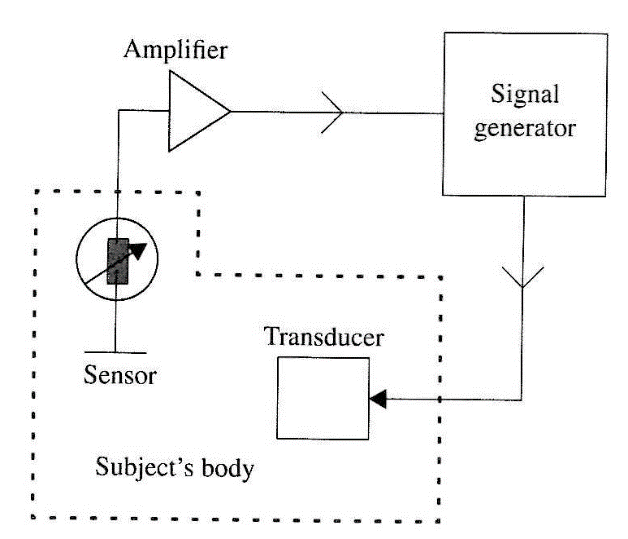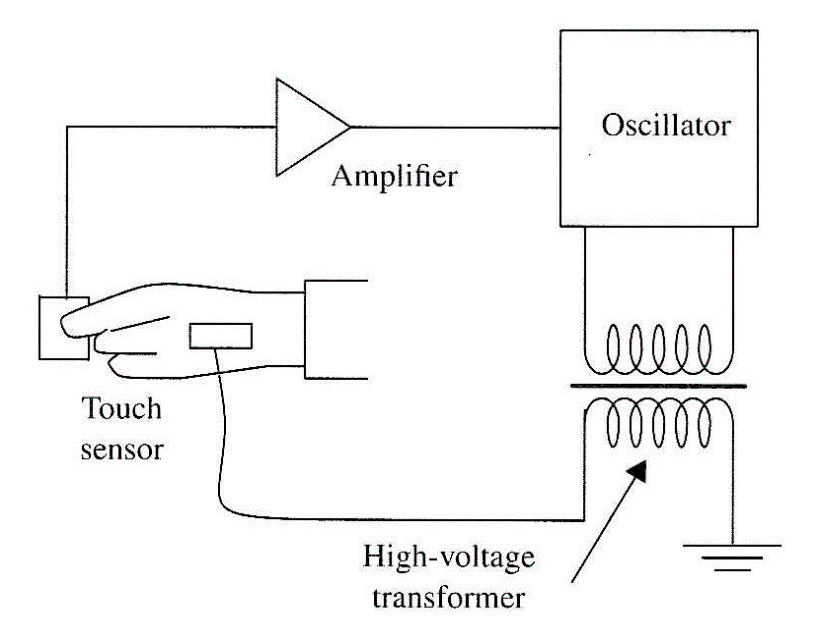Note: This article is part of my book Electronics Projects from the next Dimension published in the United States in 2001. The text is based on a series of articles we have published in magazines and books in Brazil. Updates were made.
It isn't only art that's incompatible with happiness;
it is also science. Science is dangerous;
we have to keep it most carefully chained and muzzled.
Aldous Huxley (1894-1965)
it to help stroke victims recover movement in paralyzed muscles. Physiologists use it to help tense and anxious patients learn to relax. Using biofeedback, patients can control blood pressure, skeletomuscular responses, heart rate, peripheral skin temperature, and bowel functions.
But it is not only in medicine that biofeedback can be used. In paranormal experiments, biofeedback can help the researcher to find some special mental or physiological state that is favorable to the experiments as in PSI, clairvoyance, psychometry, telepathy, and transcendental meditation.
Biofeedback means to sense some kind of information about the person's body and use it to control or change some physiological process. For instance, variations of one's blood pressure can be fed back in the form of information that can be sensed by our sense organs (the flash of a lamp or the pitch of a tone) so that the person becomes aware of those blood pressure changes. With this awareness, the subject then has a chance of assuming control over that biological function. Hence, the term biofeedback: by monitoring various bodily functions, people can control their operation (bio meaning life in Greek).
Electronics Is Not Necessary but Interesting
It is not necessary to enlist the aid of electronic devices to sense changes in our body. Adepts of transcendental meditation and other mystic practices can use their own senses to take control of their physiological functions. For example, the sound of the breath or the beat of the heart can be used by trained adepts.
The continual repetition of special sets of words or sounds used by adepts of transcendental meditation can be considered a form of biofeedback, where the sounds are the information to be picked up by the ear and used to control their physiological and mind functions to achieve the relaxed state.
Where Electronics Can Help
For the researcher who is experienced with electronics, some circuits can in-crease the chance of improved results in the paranormal experiments. The use of electronic equipment can also help to identify individuals with unknown paranormal abilities and to open unexpected fields of research through the creation of new experiments.
As with the other paranormal experiments described in this book, there exist many simple circuits that anyone who has some experience with electronic construction can assemble in few hours using low-cost parts. To help the paranormal researcher who wants to try some experiments in this field, we start our projects to address paranormal sensing with some simple biofeedback circuits.
It is important to mention that many of the projects described herein, now suggested for applications in biofeedback experiments, can also be used in other paranormal experiments and even in other scientific fields. Some biofeedback circuits can be used simply to correct disorders such as tension and migraine headaches, hypertension, muscle tension, and general relaxation.
Warning: The devices described here are indicated for experimental purposes only. Do not try to use them as a solution for physical disorders without first consulting a medical doctor.
How a Biofeedback Circuit Works
The simplest circuit for a biofeedback device is shown as a block diagram in Fig. 1. Some form of sensor picks up a signal from a person's body and applies it to an amplifier stage.
The sensor can work with any physiological state that is dependent on changes in bodily functions, such as
■ Temperature
■ Blood pressure
■ Skin resistance
■ Muscular tension
■ Heart beat
■ Breath
■ Cerebral waves
The amplifier configuration depends on the signal level produced by the sensor. With a sensitive sensor, such as a diode or a light-dependent resistor (LDR), a single transistor is enough to provide a good amplification of the signal. Using less sensitive sensors or trying to detect very small changes in the person's body, an operational amplifier (opamp) is needed.
The signal picked up from the output of the amplifier stage is used to control some kind of signal generator circuit. This block produces some kind of stimulus in the person, providing sensory feedback of the detected physical changes.

An audio oscillator, for instance, can produce a tone with a pitch that changes when the signal produced by the sensor changes. In this case, we have auditory feedback. A light flasher can be used to produce visual feedback. Another possible configuration is a high-voltage generator that is used to stimulate the person to a degree that depends on the level of the signal produced by the sensor. Figure 126 shows how this electro-shock feedback works. In a complex biofeedback system, many sensors can be used to pick up signals from different parts of a person's body, and the feedback stimulus can be simultaneously visual, auditory, and sensory. The circuits described in this book use all of these stimulus types and can be adapted to form complex research systems.
The Paranormal Aspect
The number of paranormal experiments that can be created using a biofeedback circuit are unlimited. Some applications of paranormal circuits and devices are:
1. ESP. A biofeedback circuit can be used to help the subjects of the experiment to achieve a mental and physiological state that is favorable to the experiments. Concentration, relaxation, trance, fourth state of consciousness, and other mind states needed to perform the experiments can be achieved more easily with the aid of biofeedback circuits. The researcher can also investigate how biofeedback can influence the results of an experiment. Another application is for monitoring the state of the subject of the experiment.
2. Clairvoyance and psychometry. A biofeedback circuit can be used to help the subject to find the ideal mind state for the experiments. Changes in body functions can be monitored with biofeedback circuits.
3. Psychokinesis. Here also, biofeedback can help the subject of the experiments to achieve special mind states before the sessions or to monitor the subject's PK abilities.
4. EIP and EVP. It can be interesting to see how biofeedback can help the re-searcher to achieve special mind states during the experiments, and how this can influence the nature of the received voices and images. 5. Auras. A biofeedback circuit can be used to induce the "patient" into special mind states before taking the picture of his aura.
Experiments
Again, the number of experiments that the reader can create using the described electronic circuits is unlimited. Many configurations of these circuits and devices can be conceived to test paranormal abilities. Again, warn the reader against being led into false interpretations of the results when making the experiments. (See other articles in this section)





